Discussions in Brightspace enrich learning in all course formats—online, in-person, or hybrid—by facilitating meaningful conversations. The tool is key to student engagement. This guide will help you set up and manage these discussions, creating a student-centered and inclusive learning environment.
Structure
Discussion Forums in Brightspace resemble big folders that hold various Discussion Topics that are related to each other, either topically or because they take place in the same timeframe. This hierarchical model helps you organize discussions and guide learners along a structured learning path, ensuring that students have a consistent experience when participating in discussions.
In Brightspace, every Topic is nested within a Forum, so it’s most straightforward to create a discussion forum first, then create topics inside the forum. If you create a new Discussion Topic from outside of a Forum, Brightspace will allow you to place the Topic within an existing Forum or prompt you to create a new Forum for the new Topic. If you don’t select either of those options, Brightspace will automatically create a forum with the same name as your topic, which can make the Discussion area a little visually busy. It’s best to think about discussions as topics nested within forums and organize accordingly.
Example Structures
Forum: Climate Change [forum organized around a common subject]
- Topic: The Science Behind Climate Change
- Discuss the key scientific principles that explain climate change. What evidence supports these principles?
- Topic: Climate Change Policy
- Evaluate current policies aimed at mitigating climate change. What are their strengths and weaknesses?
- Topic: Personal Responsibility in Climate Change
- How can individual actions contribute to climate change solutions? Share examples of personal changes you’ve made or plan to make.
Forum: Weeks 1-3 [forum organized according to the course schedule]
- Topic: Week 1 – Solar Energy Pros and Cons
- Discuss the advantages and disadvantages of solar energy as a renewable resource.
- Topic: Week 2 – Wind Energy’s Role in a Sustainable Future
- How can wind energy contribute to sustainability? What are the challenges it faces?
- Topic: Week 3 – Biofuels vs. Fossil Fuels
- Compare and contrast biofuels with fossil fuels in terms of efficiency, sustainability, and environmental impact.
Glossary
Discussion Forum
A group of related discussion topics.
Topic
An area in Brightspace where the instructor states what will be discussed and in which discussion take place. Topics are created within forums. Topics can be graded.
Thread
Within a Topic there can be many threads, each made up of an initial post and any replies to that post. In Brightspace, to post within a Topic you must create a new thread or reply to an existing thread.
Quick Tips
Organize discussions
Think about the structure of forums and the topics that fit into them, and how they fit into your course, either according to the subject matter or the course schedule. Create forums and topics accordingly.
Discussion Topics
Try to create prompts that generate meaningful discussion, rather than ones that ask a question that has a set answer. Discussions are more engaging when students can reflect and respond to one another.
Availability settings
Be aware of the Visibility toggle when creating Forums and Topics. If a Forum is not visible to students, then none of the Topics within it will be visible either.
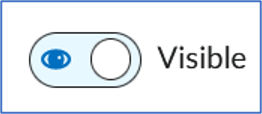
How to
Access the Discussions tool
Option A – From Discussions
- From your course navbar, click on Activities and choose Discussions on the pull-down menu.
- In the Brightspace Discussions area, you can create a new Forum and then create new Topics for that Forum.
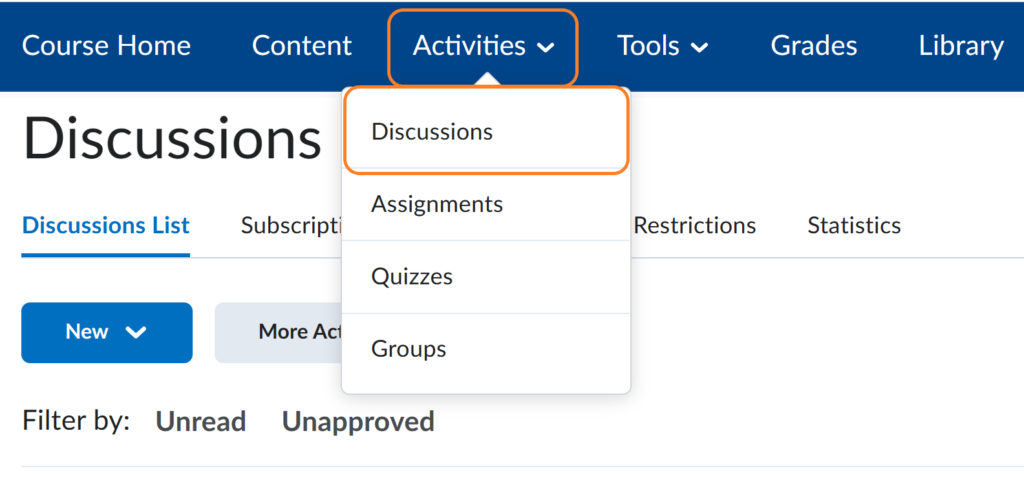
Option B – From Content
- From your course navbar, navigate to Content.
- Click into a content module.
- Click on the Upload/Create button.
- Select New Discussion from the list.
- A window will open to create a new Topic.
- In the Brightspace Content area, you can create a new Topic, and then create a new Forum for that Topic.
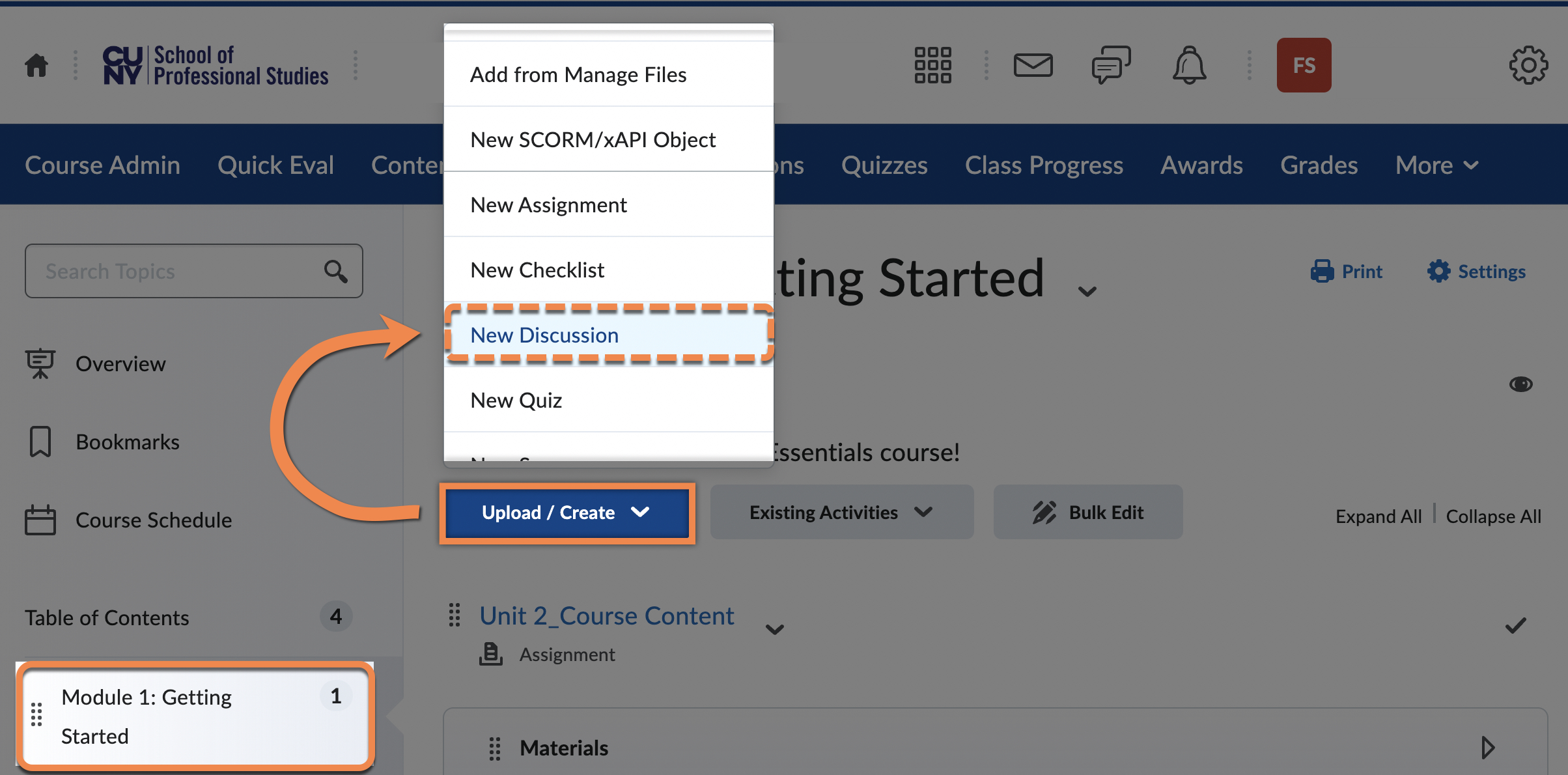
Create a new forum
Discussion Forums are the top organizing level and are used to house Discussion Topics. Note that since Forums are structural, students can’t do anything in an empty Forum. Discussion Topics must be added by the instructor for discussions to take place.
Option A — From Discussions
To create a new Forum in the Discussions area, click the New button and select New Forum.
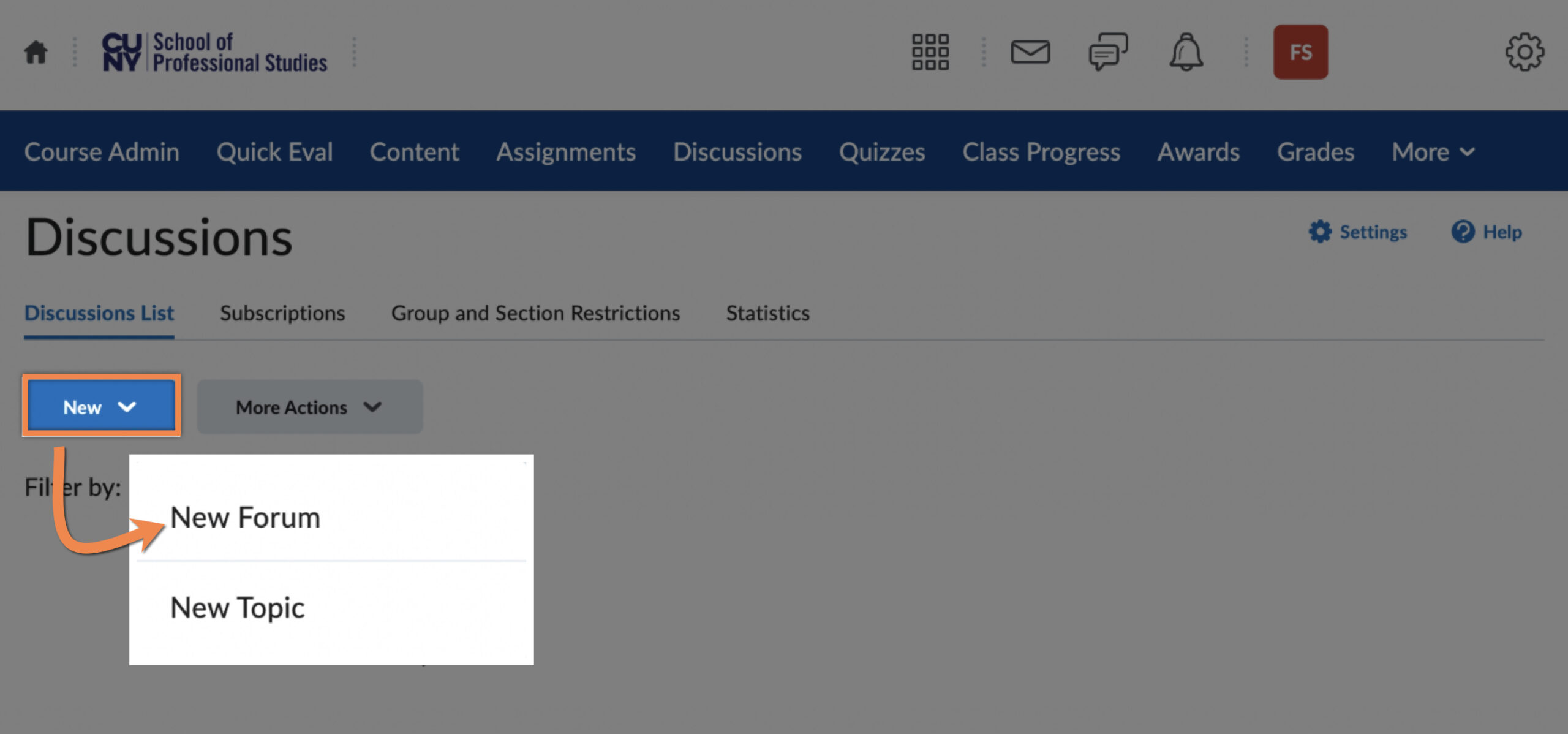
Option B – When creating a new Topic
When you create a new Topic, by default, Brightspace will create a new Forum for it with the same title. However, you also have the option at this step to change the forum for the topic to an existing one or create a new one.
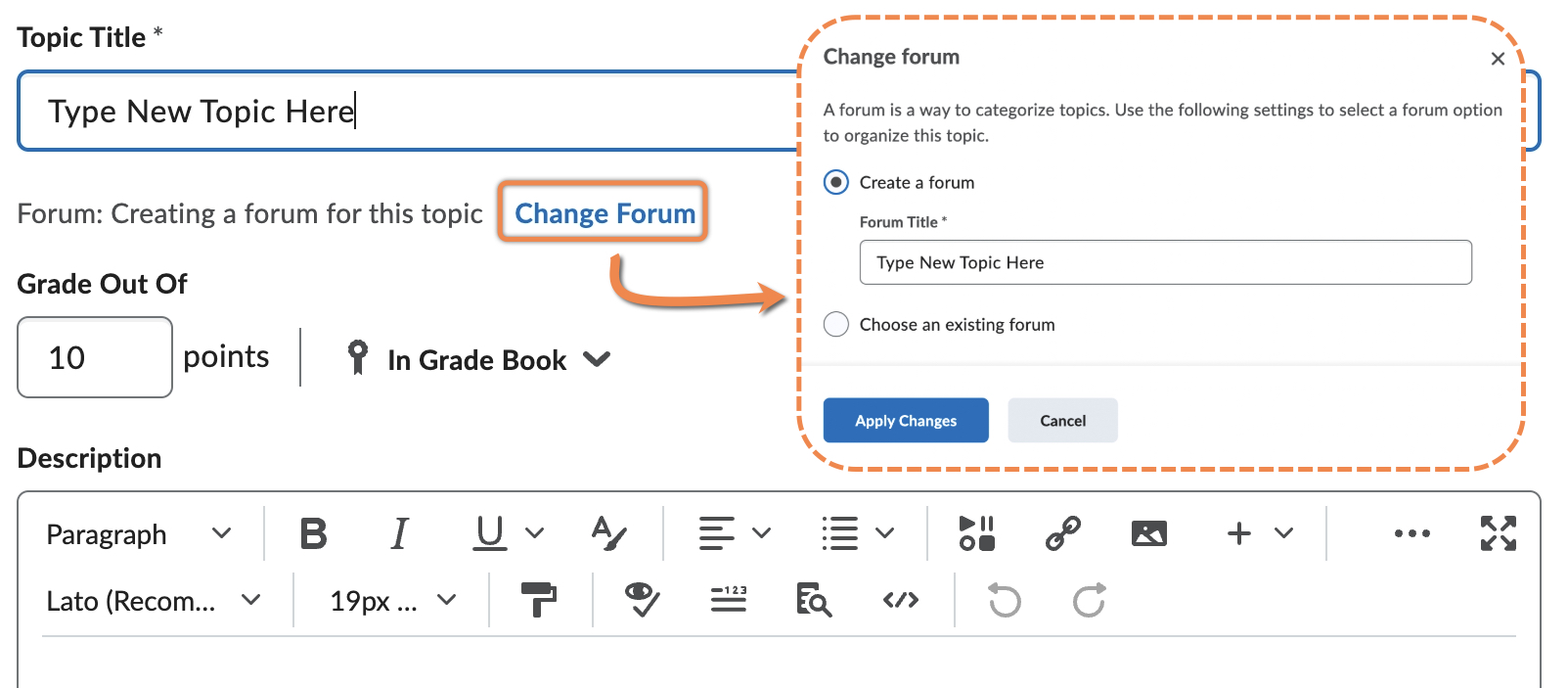
Set forum properties
Whenever you create a new forum, the forum’s Properties window opens.
- You must provide the forum a title.
- You can add a description of the forum.
- Remember to use the Accessibility Checker for the forum description.
- In addition, on the Properties page there are settings for common options.
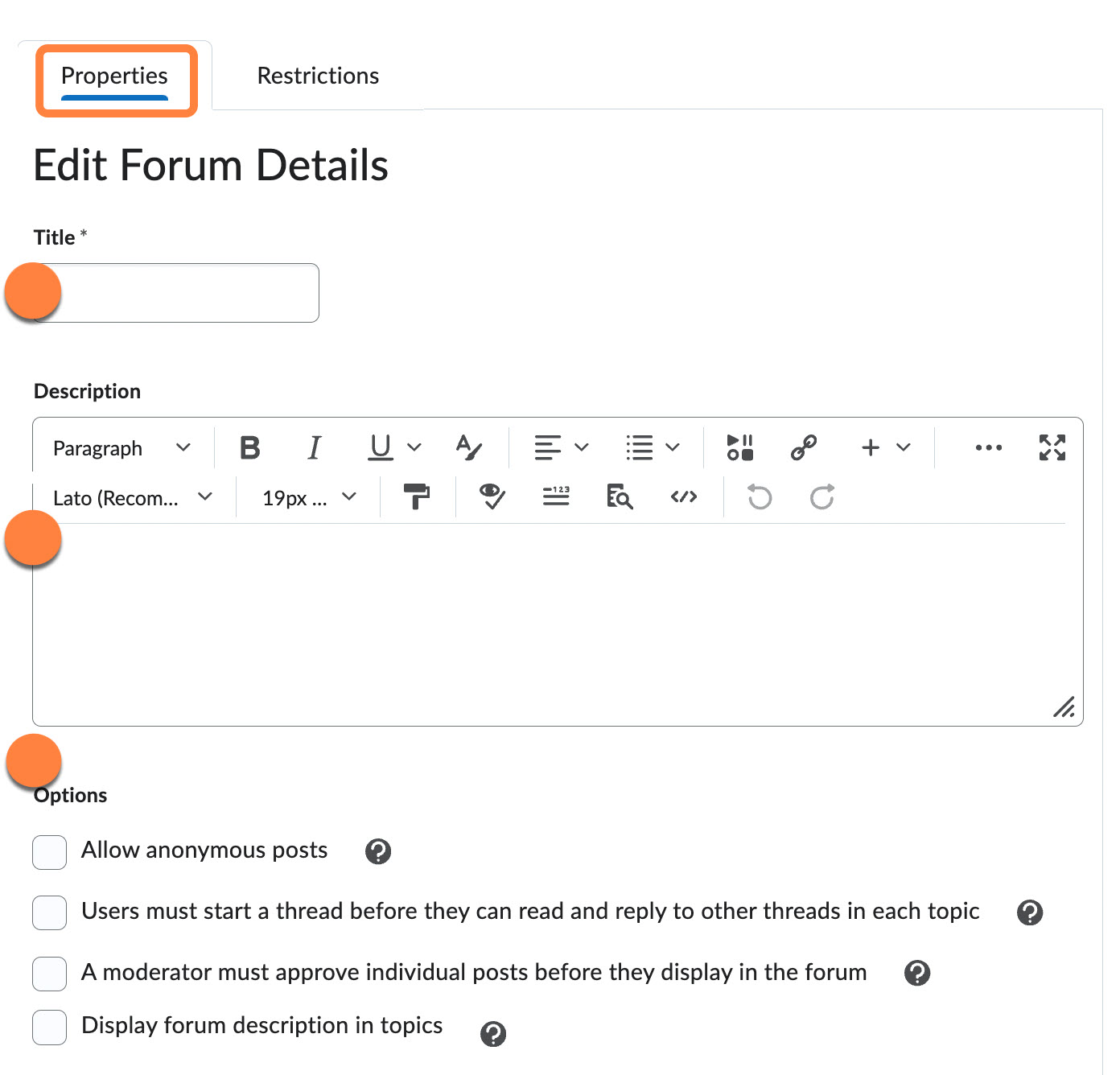
Forum Options
- Allow anonymous posts: Enables students to post with their names hidden.
- Users must start a thread before they can read and reply to other threads in each topic: Students are required to create their own thread before they can read and reply to their classmates’ threads.
- A moderator must approve individual posts before they display in the forum: With this option selected, the instructor must read and approve each student response before making it visible to the class.
- Display forum descriptions in topics: If checked, students will see the description within an individual topic, in addition to the topic prompt.
Note: All settings for a Discussion Forum will apply to every Topic within the Forum.
Set forum restrictions
On the Forum Restrictions tab, you can set availability or visibility conditions for the forum. All restrictions on the availability of a forum will apply to all the Topics nested within it. For this reason, you’ll generally want to leave the default settings for Forum Restrictions, and instead, apply any availability restrictions to the individual Topics within the Forum.
Add a new topic
In Brightspace, Discussion Topics are where students can start new threads and reply to threads, engaging in conversation. A Discussion Topic is where instructors state what is to be discussed and provide instructions for how students should participate in the discussion. Discussion Topics can be graded.
Option A
- From your course navbar, navigate to Activities and choose Discussions.
- Navigate to the forum in which you want to place the new topic.
- Click on the arrow next to the forum name.
- Select Add Topic.
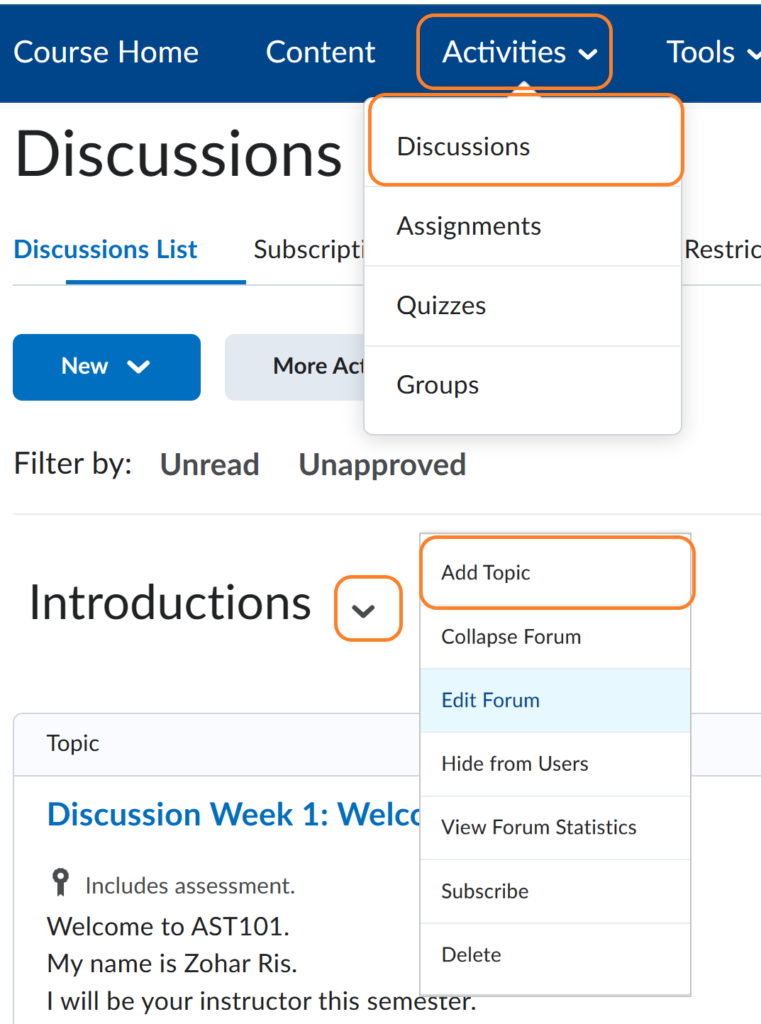
Option B
- From your course navbar, navigate to Activities and choose Discussions.
- Click on New and New Topic.
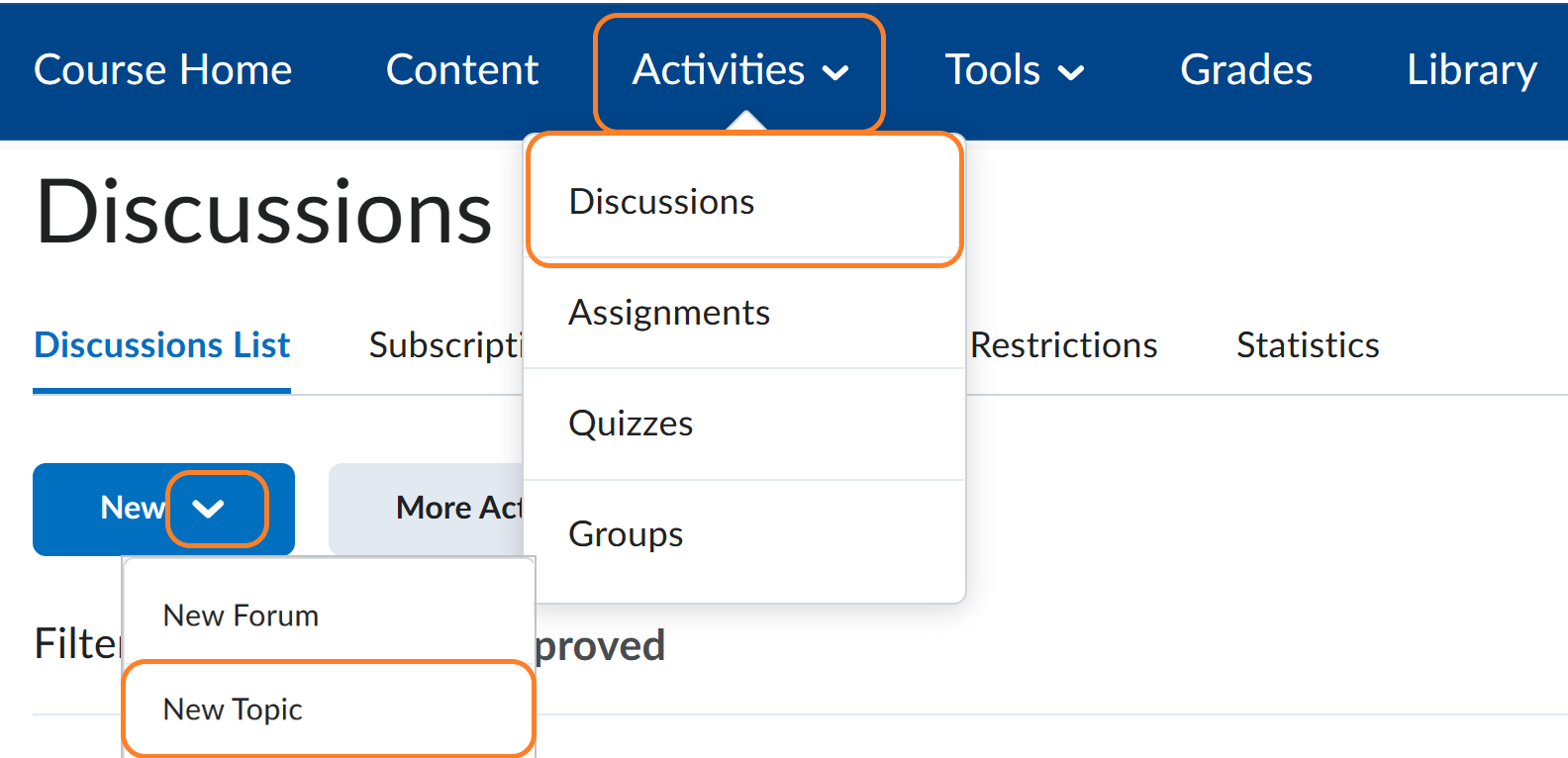
Option C
- Navigate to the module or submodule where you would like to insert the discussion topic.
- Click on Upload/Create.
- Choose New Discussion.
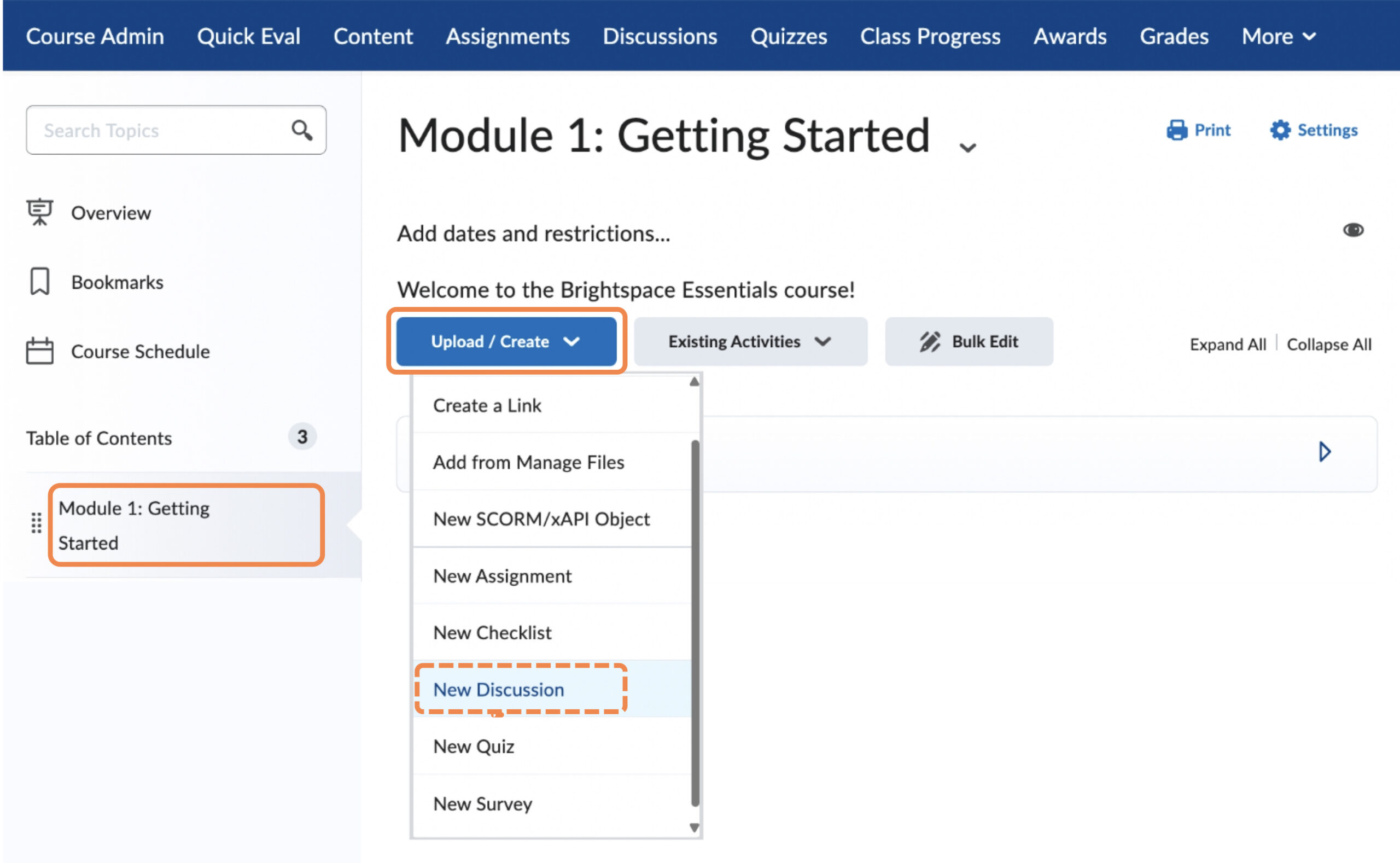
Add topic instructions and make it gradable
On the Topic settings page you will give the topic a title, you can change the forum that the topic is nested in or create a new forum (by default Brightspace will create a forum with the same title as the topic), you can decide if the discussion topic will be graded, and you can add a discussion prompt and instructions to the topic description. The fields you can modify, in order from top to bottom, are:
- Topic Title: enter the Topic title. This field is required.
- Forum: you can change the Forum under which the topic is nested.
- Grade Out Of: add the maximum points possible if you want to grade the Topic. Leave the Ungraded option if you don’t wish to grade the Topic.
- Description: add instructions and the discussion prompt in the Description box. Remember to use the Accessibility Checker in the Brightspace Editor for the topic description.
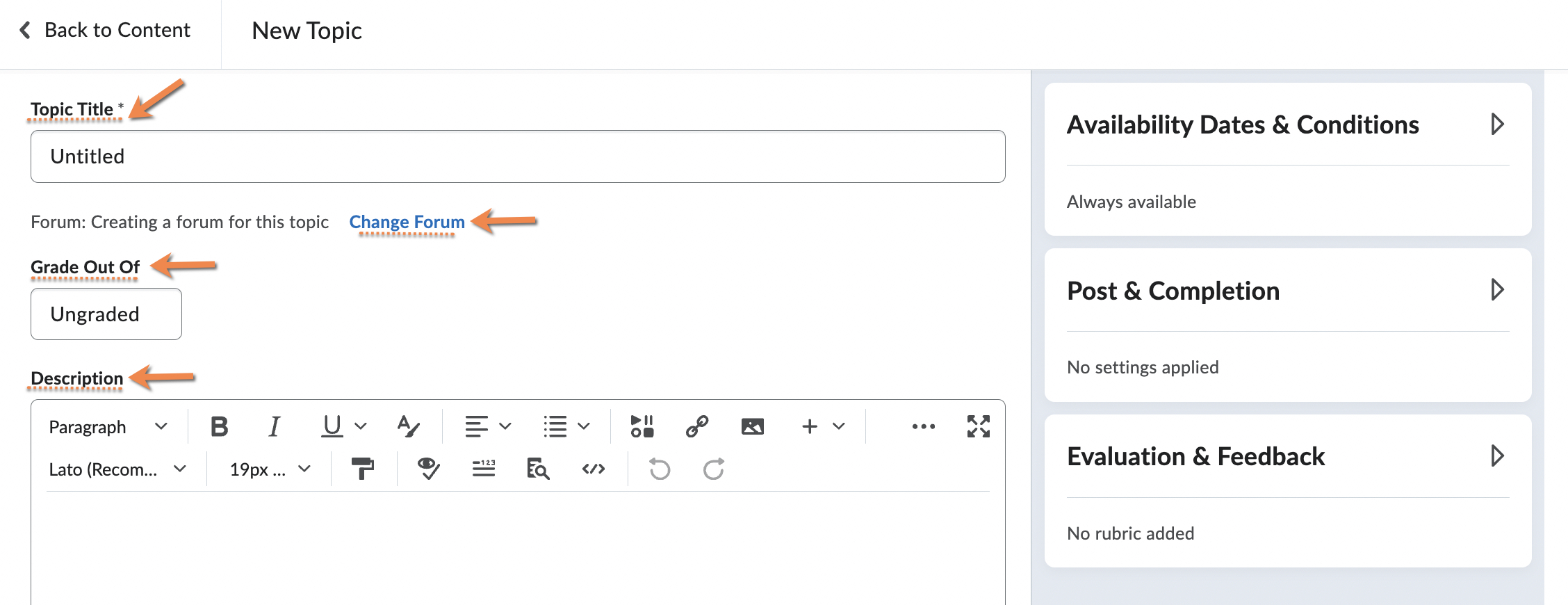
On the Topic settings screen you can also set up:
- Availability Dates & Conditions
- Post & Completion
- Evaluation & Feedback
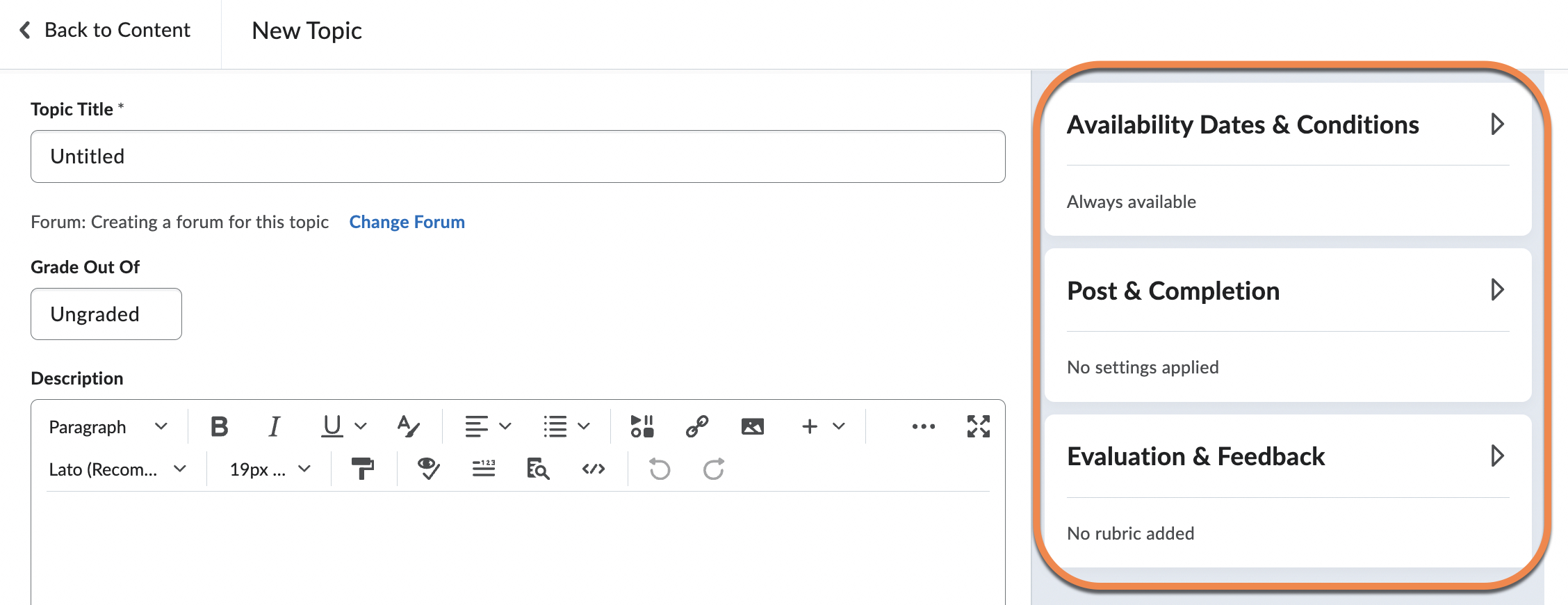
Set topic availability dates & conditions
You can restrict the availability of the topic with start and end dates, according to other release conditions (ex., completing the module readings), or by group or section.
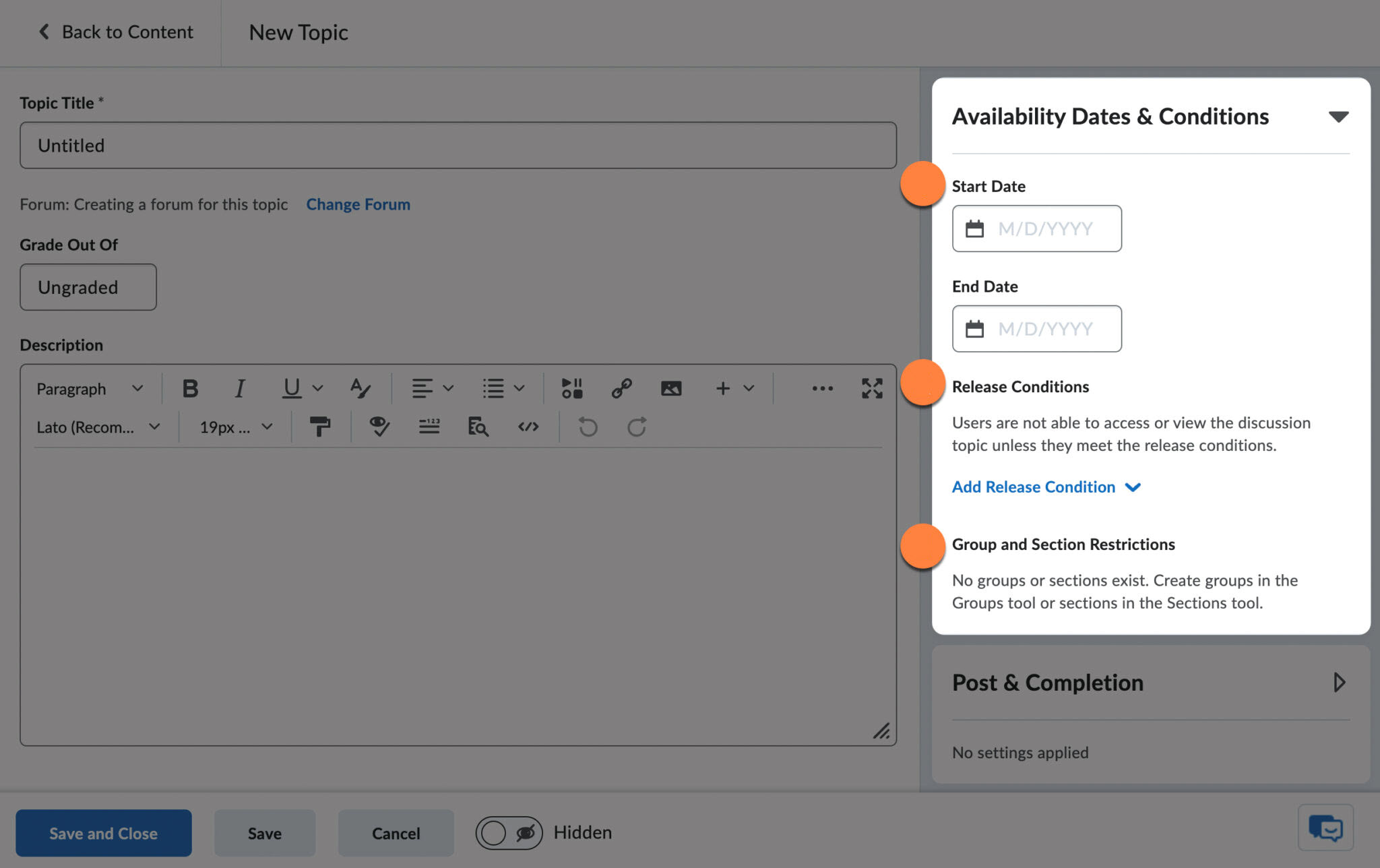
Set topic post & completion options
If you wish, you can allow anonymous posts (note that Instructors and Administrators can still see the names associated with each post), set the topic to be “post-first” (learners must create their own thread before they can read or reply to other threads), or make the topic moderated (posts must be approved before they are displayed to the whole class).
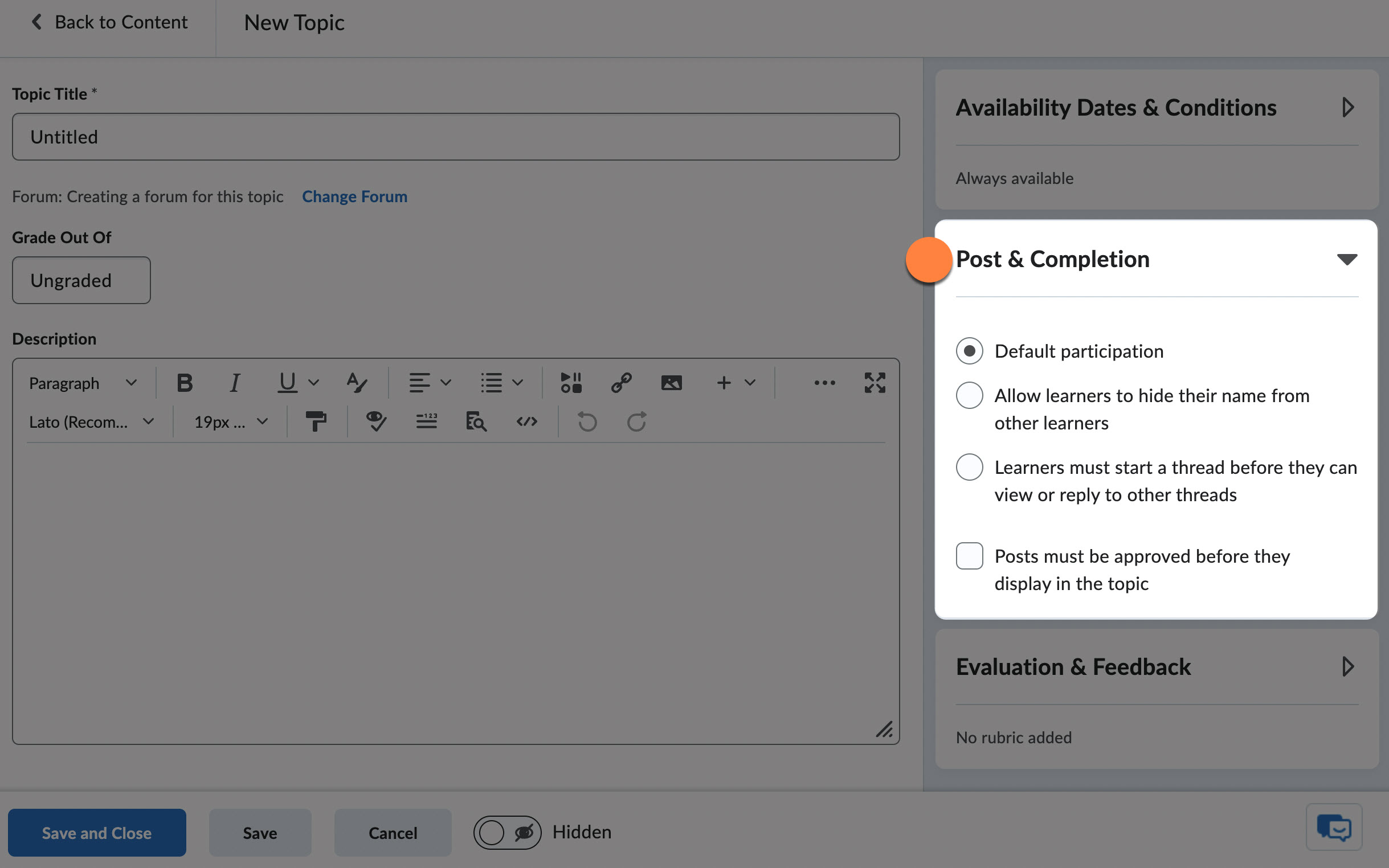
Set grading & feedback options
In Brightspace, feedback options for discussions include rubrics, grading individual posts, and allowing learners to rate each other’s posts.
- Rubric: add a rubric to grade student responses. You can either select an existing rubric or create a new one.
- Evaluate Posts: set individual student responses to be graded separately and allow students to rate their classmates’ posts.
- Allow Learners to Rate Posts: In Brightspace, the option “Allow learners to rate posts” means that students are allowed to score or rate their peers’ posts in a discussion. This feature mimics what learners are used to on social media. This can increase peer-to-peer interaction and provide learners with feedback on their posts. It can also be useful in situations where you want to get a quick read on whether your learners agree or disagree with a point.
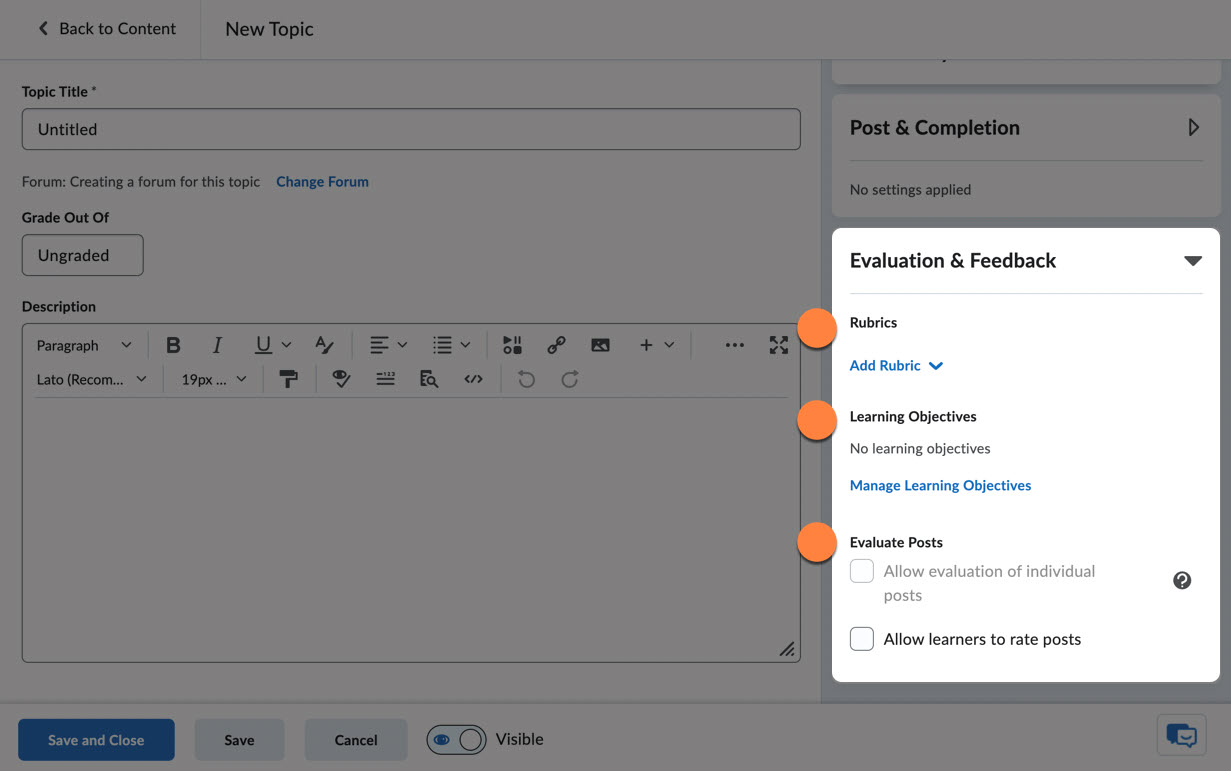
Make the topic visible to students
The Topic Visibility setting, at the bottom of the New Topic window, controls whether students can see the discussion topic. When students see the topic can be further fine-tuned by Topic Availability Dates & Conditions. Recall that Forum-level visibility and availability conditions override Topic settings: if a Forum is unavailable, all the Topics within the forum will be inaccessible regardless of their individual settings.
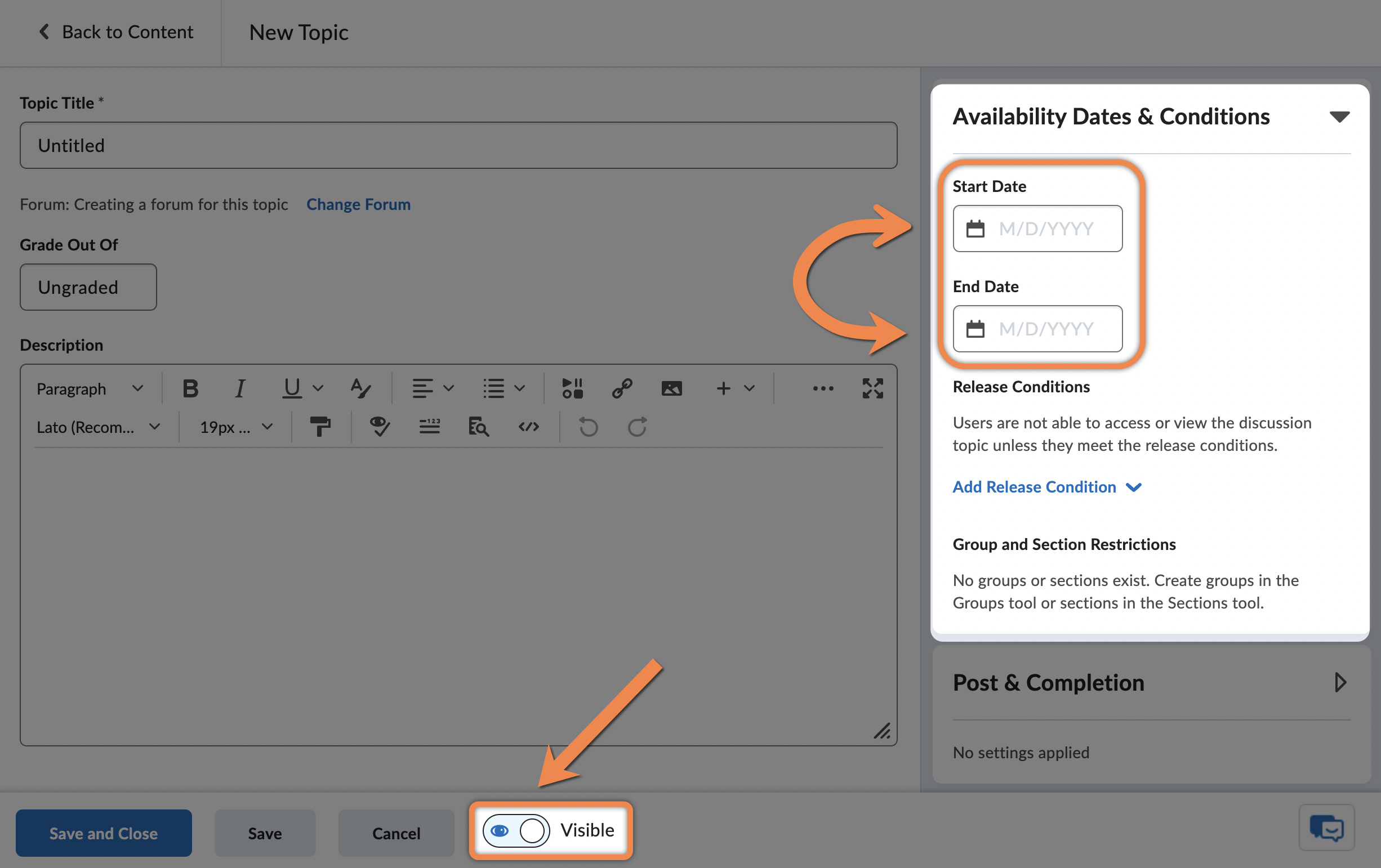
Save your work
Save: allows you to save your progress without exiting the editing mode. It is useful if you want to continue working or need to double-check settings.
Save and Close: saves your changes and takes you out of the editing mode, bringing you back to the main Discussions or Topics list.
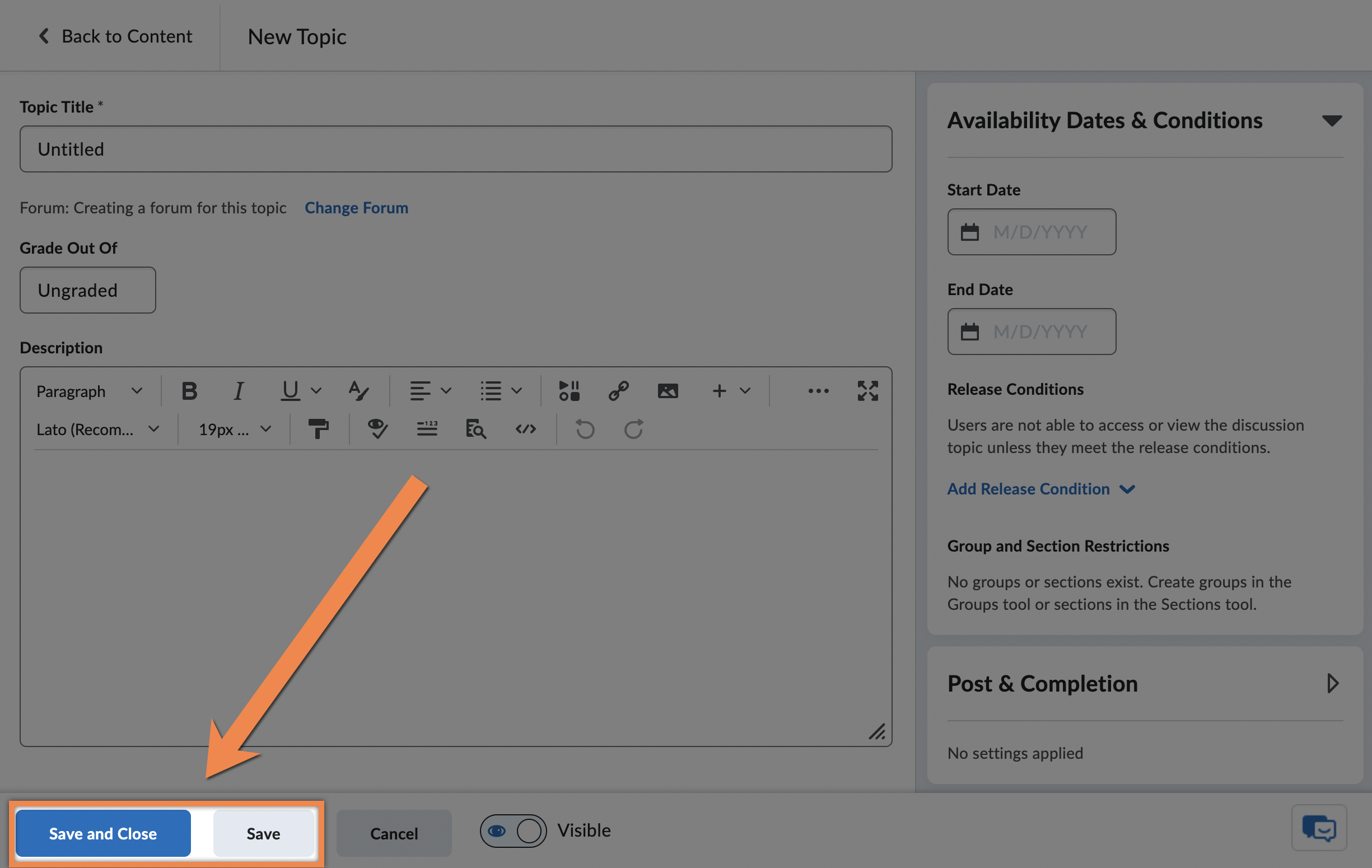
Test Your Knowledge
Take Action
- Create a discussion forum in your practice site.
- Create two discussion topics in the forum.
- Try setting up grading and evaluation and feedback options for one of the topics
Resources
Text
Brightspace Community: Create a discussion forum
Brightspace Community: Create a discussion topic in the Classic Content Experience
CUNY Brightspace Transition: Training and Resources
CUNY SPS Accessibility Toolkit
Video
Create a discussion forum
Create a discussion topic
Grade a discussion topic
Assess from within a thread
Discussion statistics
Use Discussions for Journaling